
The Cobblestone Historic District is located along state highway NY 104 in Childs, New York, United States. It comprises three buildings that exemplify the cobblestone architecture developed to a high degree in the regions of upstate New York near Lake Ontario and exported to other areas with settlers. It is the location of the Albion-based Cobblestone Society's Cobblestone Museum.

26 Center Avenue in Reading, Massachusetts is an architecturally eclectic cottage, with a mix of Greek Revival, Gothic Revival, and Italianate features. Built c. 1854–1875, it is a rare surviving remnant of a residential subdivision once dubbed "Mudville" for the condition of its unpaved roads. The house was listed on the National Register of Historic Places in 1984.

Cobblestone Farmhouse at 1229 Birdsey Road is a farmhouse in the town of Junius, New York, in Seneca County, New York. It is significant as a well-preserved example of cobblestone architecture, in a vernacular Greek Revival style. North of the house, there is also a large barn believed to date to the late 19th century. This property was listed on the National Register of Historic Places on August 6, 2008. It is the sixth property listed as a featured property of the week in a program of the National Park Service that began in July, 2008.

The Cobblestone House in Eau Claire, Wisconsin is a Gothic Revival style house that was built in 1866. It reflects cobblestone architecture brought by settlers from upstate New York. It has also been known as Bradley H. Marcy House. It was listed on the National Register of Historic Places in 1974; the listing included one contributing building and one other contributing structure.

Charles Bullis House is a historic home located at Macedon in Wayne County, New York. The Federal style, cobblestone house consists of a 2-story main block with a 1+1⁄2-story frame wing. It was built about 1839 and is constructed of irregular, rough, moderate sized cobbles. The house is among the approximately 170 surviving cobblestone buildings in Wayne County.

The John Littig House is a historic building located on the northwest side of Davenport, Iowa, United States. The Gothic Revival style residence was built in 1867 and has been listed on the National Register of Historic Places since 1984 and on the Davenport Register of Historic Properties since 1993.
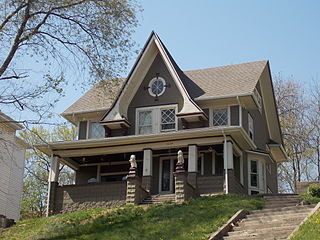
The Henry Ockershausen House is a historic building located in a residential-light industrial neighborhood on the east side of Davenport, Iowa, United States. It has been listed on the National Register of Historic Places since 1984.
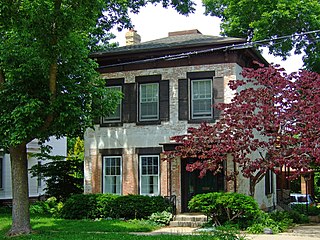
Hyer's Hotel is the oldest surviving urban hotel building in Madison, Wisconsin. Built in 1854 a half mile east of the capitol, it was added in 1983 to the National Register of Historic Places.
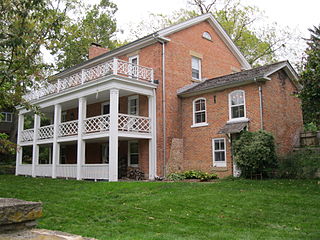
The Old Spring Tavern was built as a stopping place in 1854 on the Madison-Monroe stagecoach road. The city of Madison, Wisconsin has grown around the old Greek Revival-styled building and in 1974 it was added to the National Register of Historic Places.

St. Patrick's Church is a historic Catholic church built in 1885 in Eau Claire, Wisconsin. It was added to the National Register of Historic Places in 1983 for its architectural significance.
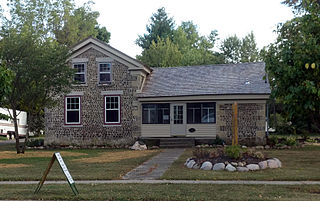
The Richardson-Brinkman Cobblestone House, located at 607 W. Milwaukee Rd. in Clinton, Wisconsin, United States, is a cobblestone house in Greek Revival style that was built in 1843. It has also been known as simply Cobblestone House. It was listed on the National Register of Historic Places in 1977. The listing included two contributing buildings.

The Eli R. Cooley House is a Greek Revival-styled house built in the early 1850s in Racine, Wisconsin. It was listed on the National Register of Historic Places in 1973 and has been described as "Wisconsin's finest remaining Greek Revival residence."

The Corse-Shippee House is a historic house at 11 Dorr Fitch Road in West Dover, Vermont. Built in 1860, it is one of the village's finest examples of high-style Greek Revival architecture, and is sited on one of the few town farmsteads that has not been subdivided. The house was listed on the National Register of Historic Places in 2008; it was previously listed as a contributing property to the West Dover Village Historic District.
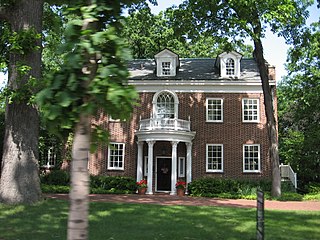
The North Broadway Street Historic District is a 28-acre (11 ha) historic district in De Pere, Wisconsin which was listed on the National Register of Historic Places in 1983. It included 47 contributing buildings and seven non-contributing ones.
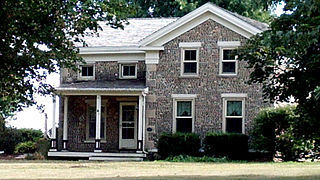
The Samuel S. Jones Cobblestone House is a large Greek Revival-styled farmhouse built in Clinton, Wisconsin in the late 1840s. The house was listed on the National Register of Historic Places in 1978 and on the State Register of Historic Places in 1989.
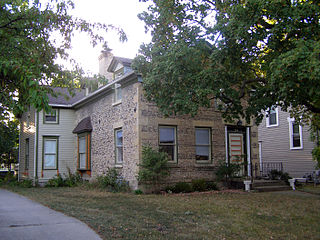
The Lathrop-Munn Cobblestone House is a 1.5-story Greek Revival-styled house built about 1848 in Beloit, Wisconsin, striking for the care with which the mason arranged the tiny cobbles. In 1977 the building was placed on the National Register of Historic Places.

The Rollin Sprague Building, also known as the Old Stone Store, is a commercial building located at 300 Main Street in Rochester, Michigan. It was listed on the National Register of Historic Places in 1999. The building is a rare example of coursed, cobblestone construction, and is the only known commercial building in Michigan featuring this type of construction.

The C. R. Howard House, at 411 E. Garfield St. in Aurora, Ohio is a historic cobblestone architecture house built in 1853. It was listed on the National Register of Historic Places in 1974.

The Orton Park Historic District is a residential historic district on the near east side of Madison, Wisconsin. The district is centered on Orton Park, the first public park in Madison, and includes 56 houses facing or near to the park. The first houses in the area were built in the 1850s during a local housing boom; however, after the Panic of 1857 ended the boom, development in the area halted. When Orton Park was developed out of a former cemetery in the 1880s, more houses were built near the park; construction in the district continued through the 1950s. Many houses in the district were designed in the Queen Anne, Prairie School, and Craftsman styles, and local architects Claude and Starck designed at least seven houses in the district. The district also includes examples of Greek Revival, Italianate, and Colonial Revival architecture.

The South Main Street Historic District is a surviving collection of eleven commercial buildings built from 1877 to 1915 in the old downtown of Oregon, Wisconsin, plus the WWI memorial. It was added to the State and the National Register of Historic Places in 2000.























